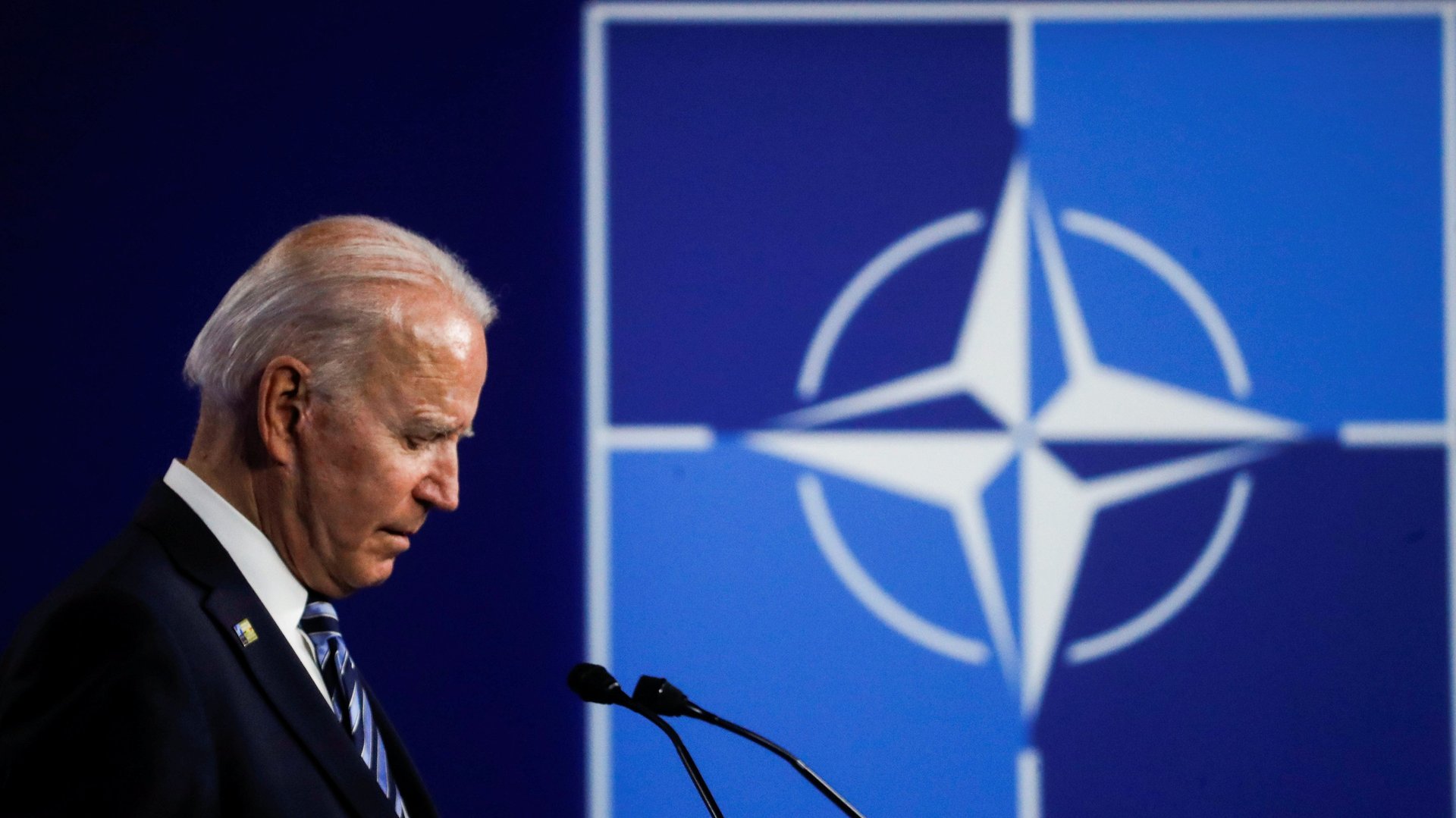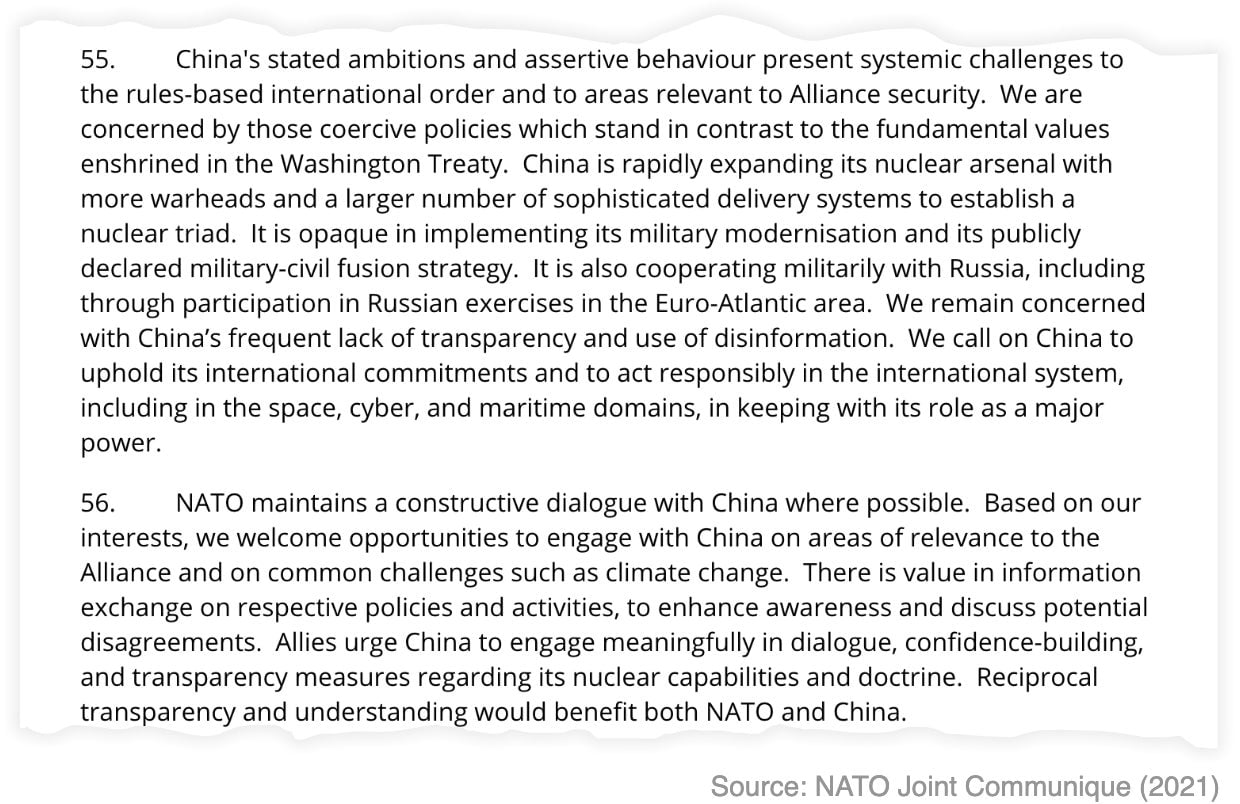China reacts to the conclusions of the NATO summit
The yearly meeting of North Atlantic Treaty Organization (NATO) members wrapped up this week (June 14) in Brussels, capping off a busy week of multilateral events that also included the G7 summit in Cornwall, southwest England.


The yearly meeting of North Atlantic Treaty Organization (NATO) members wrapped up this week (June 14) in Brussels, capping off a busy week of multilateral events that also included the G7 summit in Cornwall, southwest England.
It’s an important time for both the G7 and NATO, two institutions with a common mission and considerable overlap in their membership. They face major challenges, including stabilizing and improving relations with China and Russia, achieving progress on climate change, ensuring that another pandemic doesn’t ever happen, and stimulating the global economic recovery from Covid-19. They also had to agree on an agenda to carry NATO through the next 10 years.
NATO and China
In fact, this year was the first in which both NATO and the G7 singled out China as a security risk.

Beijing didn’t take kindly to this: In a statement, the Chinese mission in the EU said that “NATO is slandering China’s peaceful development” and “represents a continuation of the Cold War mentality and bloc politics.”
“China will not present ‘systemic challenges’ to anyone, but we will not sit by and do nothing if ‘systemic challenges’ come closer to us,” the mission added.
What is NATO (and why is it sometimes spelled OTAN)?
NATO is a military alliance of 30 countries in Europe and North America organized around the principles of the 1949 North Atlantic Treaty, which was signed by the US, Canada, and 10 European countries to defend “the principles of democracy, individual liberty, and the rule of law” in the early days of the Cold War.
You may have seen NATO spelled as OTAN before. That’s because the organization’s second official language is French, and in French, OTAN stands for “Organisation du Traité de l’Atlantique Nord.”
The core principle of NATO is collective defense: If one member is attacked, all should respond. In practice, that principle is enshrined in Article 5 of the North Atlantic Treaty, and it has only been triggered once, after 9/11. Following that attack, individually and as a group, NATO members took steps to support US counter-terrorism operations overseas.
Who are NATO members?
There are 30 members of NATO, the most recent of which—North Macedonia—joined last year. Membership in the organization is “open to any other European state in a position to further the principles of this Treaty and to contribute to the security of the North Atlantic area.”
NATO member countries (followed by the date they joined) are:
NATO also partners with non-member states to carry out its missions, including Afghanistan, Japan, and New Zealand.
How does NATO work?
NATO is funded through contributions by member states, which are broken down into two buckets: Direct contributions to its operational management based on countries’ size and means, and national defense budget contributions that fund its crisis management missions around the world.
NATO does not have its own armed forces; instead it has the Allied Command Operations, which plan and execute NATO military missions using member states’ troops and equipment.
NATO countries commit to spending at least 2% of their GDP on defense. In the past, few European countries have met that target, which led to tensions with the US. Former US president Donald Trump called NATO “obsolete” partly for that reason. NATO itself criticizes member states for this:
“The combined wealth of the non-US Allies, measured in GDP, exceeds that of the US. However, non-US Allies together spend less than half of what the US spends on defense. This imbalance has been a constant, with variations, throughout the history of the Alliance.”
Where is NATO?
NATO headquarters are in Brussels, Belgium. The Allied Command Operations are located in Mons, Belgium, and known as the Supreme Headquarters Allied Powers Europe, or SHAPE.
What is the NATO summit?
Every year the leaders of NATO’s 30 member countries meet for a summit. This year, the main item on the agenda was to agree on steps to reform the alliance for the future, under an initiative launched in 2019 and known as NATO 2030.
“By agreeing the NATO 2030 agenda, leaders have taken decisions to make our Alliance stronger and better fit for the future,” NATO secretary general Jens Stoltenberg said at the end of the summit.
Why was Joe Biden late to NATO?
US president Joe Biden was two hours late to a press conference following the NATO summit, which caused some speculation after Ukrainian president Volodymyr Zelensky implied in a tweet that Ukraine’s bid to become a member of the alliance was successful.
It’s now clear that nothing has changed about Ukraine’s NATO status. In 2008 NATO agreed that Ukraine would become a member one day. At this year’s summit, it simply reiterated that commitment.
Biden and Putin
Changing Ukraine’s NATO status would have been a remarkable development, since Biden is set to meet Russian president Vladimir Putin in Geneva this week (June 15), and Russia has long considered its neighbor Ukraine joining NATO as a geopolitical red line. Russia invaded and annexed the Ukrainian territory if Crimea in 2014, and tensions flared up again recently with Russian troops mobilizing near eastern Ukraine.